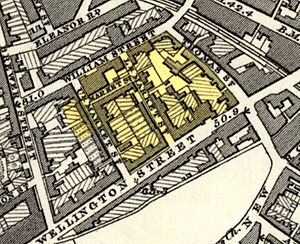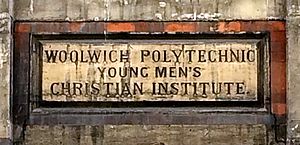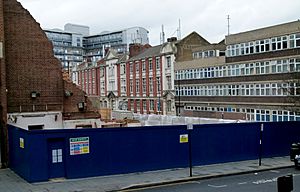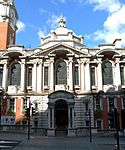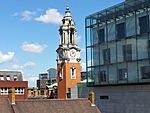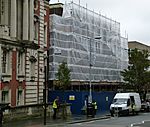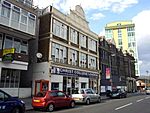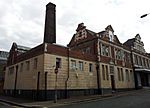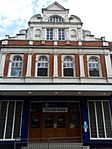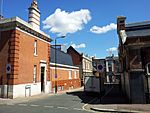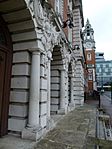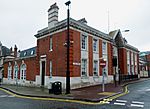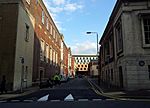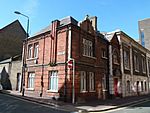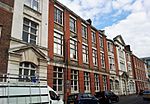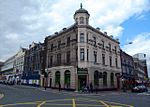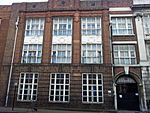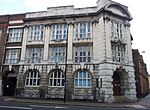Bathway Quarter facts for kids
The Bathway Quarter is a special historic area in the middle of Woolwich, a part of South East London. Many buildings here are very old and important, known as listed buildings. This means they are protected because of their history and design. The whole area is also a conservation area, which helps keep its unique look and feel. Most of these buildings were built in the late 1800s or early 1900s. They were often designed by a local architect named Henry Hudson Church and were used for important public services.
Contents
Where is it?
The Bathway Quarter is surrounded by several streets. To the south is Wellington Street, to the west is Market Street, to the north is Calderwood Street, and to the east is Thomas Street. Polytechnic Street cuts through the middle, dividing the area into two parts. The western side has many old public buildings, while the eastern side is mostly made up of former Polytechnic buildings, which were used for education. A small street called Bathway runs through the area from east to west, giving the whole quarter its name. The Bathway Quarter is also very close to Woolwich Arsenal station, making it easy to visit.
A Look Back in Time
Before the late 1700s, the area that is now the Bathway Quarter was mostly empty land. The older part of Woolwich was closer to the River Thames and the Woolwich Ferry. Some small houses from the 1760s can still be seen on Thomas Street, but they are not officially part of the Bathway Quarter.
Real development started around 1799. Two brothers, who were brewers from Greenwich, leased the land. Later, in 1812, an Irish merchant named Robert Ogilby bought most of it.
Thomas Street and William Street (now Calderwood Street) were created around 1805. Wellington Street was also built around this time to connect military areas. It became an important shopping street, though not as busy as Powis Street. A new market was set up around 1810, but it didn't last. Its name lives on in Market Street.
The first Woolwich Town Hall was built in 1840. But it was quickly sold to the police to be a court! So, an almost identical building was built nearby to be the *actual* town hall. The first one was knocked down around 1900, but the second one is still standing. The current, grander town hall was built between 1903 and 1905. Other important public buildings followed, like the police station (1910), the Magistrates' Court (1912), the public baths (1894), the public library (1901), and a community health center (1939).
A very exciting private building was the Grand Theatre, which opened in 1900. It was said to be the biggest theatre outside central London, holding 1680 people! It later became the Woolwich Hippodrome, showing variety acts, and then a full-time cinema. The building was knocked down in 1939 and rebuilt after the war as the Regal Cinema. From 1982 until 2015, it had various uses, including a nightclub.
Woolwich Polytechnic started in 1891. It was one of the oldest polytechnics in the UK. The original building is still on Calderwood Street, though it has changed a lot. Over the years, the Polytechnic grew, taking up most of the eastern part of the Bathway Quarter. Its growth even led to two streets being renamed: Lower Market Street became Polytechnic Street, and William Street became Calderwood Street. In 1970, Woolwich Polytechnic joined with other colleges to form Thames Polytechnic, which later became the University of Greenwich in 1992. The university moved out of Woolwich in 2001, and the old Polytechnic buildings are now used for businesses and education.
What's Next for the Quarter?
Woolwich is seen as an "opportunity area" in London, meaning it has potential for growth and improvement. Greenwich Council wants to make Woolwich an even better place for jobs, shopping, and fun. They also want to improve the look of its buildings and streets. The Bathway Quarter, along with other nearby areas, was made a conservation area in 2012.
The plan for the Bathway Quarter is to turn it into a cool, modern area with bars, art galleries, and artist studios. It might even have a jazz club and other creative businesses.
Many of the old public buildings are no longer used for their original purpose. For example, the Old Public Library now houses a local business support group. The Magistrates' Court building has been turned into apartments, and there are plans to do the same with the old police station. In 2015, the former Grand Theatre was knocked down to make way for new homes. There are also plans to redevelop the eastern part of the Bathway Quarter. This includes restoring historic buildings, knocking down newer ones that don't fit, and creating a new entertainment area with a cinema, cafes, and restaurants.
Historic Buildings to Explore
Wellington Street
Woolwich Town Hall is a beautiful building with a grand style from the Edwardian era. It has two impressive fronts, with the main entrance on Wellington Street. The entrance is made of Portland stone and has tall columns. Its 40-meter-high clock tower can be seen from far away. Next to the town hall, the site of the former Grand Theatre is waiting to be redeveloped.
Bathway
On the south side of Bathway, you'll see the impressive brick and Portland stone front of the Woolwich Public Baths. This building, opened in 1894, used to have two large swimming pools, private baths, and a laundry. It was updated around 1960 but closed in 1982. Since then, it's been used as a community center, a student union, and now an administrative building and rehearsal studio.
Calderwood Street
The old Market House was replaced by the Police Court in 1840, and then by the Magistrates' Court in 1910. The Public Library, designed in 1897, has a detailed front made of red brick and Portland stone with a large bay window. The Old Town Hall, built in 1841–42, is a handsome classical building with "Town Hall" written on it. Further down the street, you can find the oldest Woolwich Polytechnic building from 1891.
Market Street
The red-brick side of Woolwich Town Hall runs along Market Street. Its Italian-style clock tower, 40 meters tall, has beautiful white stone decorations. The side entrance of the town hall has symbols of the military and the sea. Next to it is the west side of the Woolwich Public Baths. The former Magistrates' Court building is also on this street and is now apartments.
Polytechnic Street
The site where the Woolwich Grand Theatre used to be now offers views of the back of Woolwich Town Hall. A tall brick chimney stands over the former wash house of the Public Baths. North of Bathway, a detailed corner building from 1892 used to be the county court. It's made of red brick with stone and terracotta decorations. The east side of the street is full of former Polytechnic buildings, including the Polytechnic Lecture Hall and the Art and Science School.
Thomas Street
On the corner of Wellington Street, you'll find the former London and Provincial Bank, which is now a bookmaker's shop. The Earl of Chatham public house was rebuilt in 1898. You can also see several former Polytechnic school buildings from the 1930s. On the corner of Calderwood Street is the Rotunda building, a grand Portland stone building with a circular hall that opened in 1917.
Images for kids
-
Woolwich Police Court, 1840-1900 (an old painting from 1841, BL)



